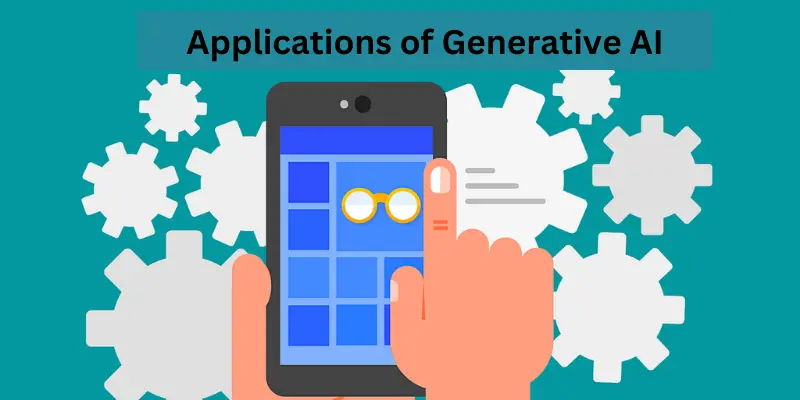AI vs Deep Learning: Key Differences and Applications
Published: 01 Jan 2025
Artificial Intelligence (AI) is transforming industries across the globe, with terms like Generative AI and Deep Learning often emerging in discussions. These terms, while related, represent different facets of the AI landscape.
Understanding their differences, functionalities, and applications is crucial for anyone looking to explore or leverage AI in today’s rapidly evolving tech world.
In this article, we’ll explore the key differences between Generative AI and Deep Learning, how each works, and their applications across various industries.

What is Artificial Intelligence technology
Before diving into Generative AI and Deep Learning, it’s essential to understand the broader concept of AI, as it is the foundation of both. what is machine vision
Artificial Intelligence (AI) refers to the simulation of human intelligence in machines that are programmed to think, learn, and problem-solve. AI encompasses a wide range of technologies, from simple automation systems to more advanced algorithms that mimic cognitive functions like learning and decision-making.
AI can be broken down into two main categories:
- Narrow AI (Weak AI): Systems designed to perform a specific task, like facial recognition or language translation.
- General AI (Strong AI): A theoretical form of AI that can perform any intellectual task that a human being can do. It doesn’t exist yet, but it’s the ultimate goal of AI research.
- Within AI, there are Machine Learning (ML) and Deep Learning (DL), both of which are subsets of AI. Generative AI is a newer term that focuses on a specific aspect of AI—creating new content based on learned data. advantages of artificial intelligence
Let’s now define Generative AI and Deep Learning in more detail.
What is Generative AI?
Generative AI is a subset of artificial intelligence that focuses on generating new, original content. Unlike traditional AI, which primarily analyzes and reacts to existing data, Generative AI creates new data that mimics real-world examples.
At its core, Generative AI uses algorithms that learn from a vast dataset and then generate new content based on that learning. For example, it can create text, images, videos, music, and even new product designs. Some well-known applications of Generative AI include tools like OpenAI’s GPT-3, which generates human-like text, or DALL·E, which creates images from text prompts. machine vision explained
How Generative AI Works
Generative AI typically uses models such as Generative Adversarial Networks (GANs) or Variational Autoencoders (VAEs) to create new content. These models use two networks: one generates the content (the generator), while the other evaluates it (the discriminator). The generator tries to create realistic outputs, while the discriminator tries to identify whether the content is real or fake. Through this back-and-forth process, the generator gets better at producing high-quality content. deep learning guide
Applications of Generative AI

Generative AI is revolutionizing various industries by creating new, original content. Here are some key applications:
Art and Design
Generative AI helps artists create new artwork, designs, and graphics based on existing styles. Tools like Deep Dream and Art Breeder can transform sketches into complex, beautiful visuals. disadvantages of artificial intelligence
Music Composition
AI can compose custom music tracks across genres. Platforms like Amper Music and Aiva allow users to generate music for videos, ads, or even movies without needing to know how to play an instrument.
Content Creation
Generative AI, like GPT-3, can generate articles, blogs, product descriptions, and even social media posts in seconds, making content creation faster and more efficient.
Game Development
In gaming, AI generates new levels, characters, or worlds based on input criteria. This speeds up development and creates endless unique gameplay experiences. artificial intelligence complete guide
Personalized Marketing
Generative AI helps businesses create personalized content for customers—like custom emails, product recommendations, or ads—based on individual preferences.
Fashion and Product Design
Designers use AI to generate unique clothing or product designs by inputting criteria like colors or patterns, speeding up the creative process.
Storytelling and Movie Scripts
AI generates movie scripts, storylines, and dialogue by analyzing large datasets of existing works, helping writers overcome creative blocks and brainstorm ideas.
Drug Discovery
In healthcare, Generative AI speeds up drug discovery by predicting how different compounds might interact with human cells, leading to faster treatments.
3D Printing and Manufacturing
Generative AI optimizes product designs for 3D printing, making them lighter, stronger, and more cost-effective. It’s widely used in industries like aerospace and automotive.
Why It’s Powerful
Generative AI creates entirely new content based on data, combining styles and patterns to produce original work faster than humans. It’s transforming creativity and efficiency across many fields, from art to healthcare.
What is Deep Learning?
Deep Learning is a subset of Machine Learning (ML) that utilizes multi-layered artificial neural networks to process large amounts of data and solve complex problems. Unlike traditional algorithms, which require manual feature extraction, deep learning models can automatically identify patterns in data through a process called feature learning.
Deep learning is often associated with technologies like voice recognition, image recognition, and natural language processing (NLP). These systems learn to recognize patterns and make predictions or classifications based on the data they have been trained on.
How Deep Learning Works
Deep learning algorithms are typically structured as neural networks, which consist of layers of interconnected nodes (or “neurons”). Each layer learns different features from the data. For example, in an image recognition task, the first layer might learn to detect edges, while deeper layers could recognize shapes, objects, or faces.
The most common deep learning architectures include:
Convolutional Neural Networks (CNNs): Primarily used for image-related tasks like facial recognition, object detection, and medical imaging. future of artificial intelligence
Recurrent Neural Networks (RNNs): Used for sequence-related tasks, such as speech recognition, language translation, and time-series forecasting.
Applications of Deep Learning
Deep learning is responsible for some of the most impressive breakthroughs in AI. Here are a few notable applications:
Autonomous Vehicles:
Deep learning models help self-driving cars recognize objects, pedestrians, and road signs, allowing them to make real-time decisions.
Healthcare:
In healthcare, deep learning is used to analyze medical images, such as MRI scans, to identify conditions like cancer or heart disease.
Customer Service:
Chatbots and virtual assistants, like Siri or Alexa, rely on deep learning models to understand and respond to voice commands.
Key Differences Between Generative AI and Deep Learning
While both Generative AI and Deep Learning are rooted in neural networks and learning from data, they serve different purposes and use different techniques. Below are the key differences:
Purpose
Generative AI is focused on creating new content (such as images, text, or music) based on learned patterns from existing data.
Deep Learning is focused on understanding and analyzing existing data to make predictions, classifications, or decisions (such as recognizing objects in images or transcribing speech).
Data Usage
Generative AI uses a training dataset to learn the distribution of data and then generates new content that fits that distribution. It’s about creativity and novelty.
Deep Learning, on the other hand, uses data to train models that can predict or classify. It’s about pattern recognition and making sense of existing data.
Models Used
Generative AI typically uses GANs, VAEs, or transformers (like GPT-3) to generate new data.
Deep Learning uses models like CNNs, RNNs, and LSTMs (Long Short-Term Memory networks) to analyze and understand data.
Complexity and Training
Generative AI can be more computationally intensive since it requires generating entirely new content from scratch, often requiring large datasets to train models effectively.
Deep Learning models also require significant computing power, especially when processing large datasets like images or video. However, their focus is on learning from existing data rather than creating new content.
Real-World Use Cases and Impact
Generative AI has shown its versatility in various industries, particularly where creativity is key:
Art & Design:
Artists use DeepDream or Runway ML to generate unique artworks or designs.
Music & Film:
AI-generated music platforms like Amper Music are transforming the music industry by enabling artists to create music tracks without traditional instruments.
Advertising:
Companies leverage AI-generated content to automatically create product descriptions or ad copy personalized to individual customers.
Deep Learning Use Cases
Deep learning is crucial in areas where pattern recognition and prediction are essential:
Healthcare: In radiology, deep learning helps doctors detect early signs of diseases, such as tumors or fractures, from X-rays and MRIs.
Transportation: Self-driving cars use deep learning to make sense of their surroundings in real-time, from detecting pedestrians to avoiding obstacles.
Retail: Deep learning helps companies like Amazon recommend products based on user behavior and preferences.
Conclusion:
While both Generative AI and Deep Learning are powerful AI technologies, they serve very different purposes. Generative AI excels at creating new, original content, while Deep Learning shines in tasks involving pattern recognition, classification, and prediction.
- What is Generative AI?
a) AI that creates new content like text and images
b) AI that solves math problems
c) AI that mimics human behavior
- Which is an example of Generative AI?
a) A self-driving car
b) AI creating art from text prompts (like DALL·E)
c) A chatbot answering questions
- What does Deep Learning mainly do?
a) Creates new music
b) Recognizes patterns in data to make predictions
c) Mimics human emotions
- Which AI model is used to generate new content like images?
a) Convolutional Neural Networks (CNNs)
b) Generative Adversarial Networks (GANs)
c) Recurrent Neural Networks (RNNs)
- Where is Generative AI used to create music?
a) Healthcare
b) Entertainment and Media
c) Retail
- Where is Deep Learning used to analyze medical images?
a) Healthcare
b) Retail
c) Manufacturing
- What’s the main difference between Generative AI and Deep Learning?
a) Generative AI creates new content; Deep Learning analyzes data
b) Generative AI is slower
c) Deep Learning is for image generation
- Which task is Deep Learning used for?
a) Recognizing faces in photos
b) Writing creative stories
c) Creating product recommendations
- How does Generative AI help in drug discovery?
a) By creating new algorithms
b) By predicting how compounds interact with cells
c) By analyzing medical reports
- What’s one benefit of Generative AI in product design?
a) It repairs machines automatically
b) It generates efficient product designs
c) It replaces human workers
Results:
0-4 Correct: 🤔 AI Newbie – Keep exploring, you’re on the right track!
5-7 Correct: 🧠 AI Enthusiast – Great job! You’ve got the basics down.
8-10 Correct: 🚀 AI Expert – Impressive! You’re ready to dive even deeper into AI.
Generative AI focuses on creating new content—like generating text, images, music, or even videos—based on patterns it learns from existing data. It’s about creativity and novelty.
Deep Learning, on the other hand, is a subset of Machine Learning that uses neural networks to analyze data and make predictions. It’s commonly used for tasks like recognizing faces in photos, translating languages, or identifying diseases in medical images.
In short: Generative AI creates new content, while Deep Learning analyzes and predicts based on existing data.
Generative AI is being used in many exciting ways across different industries:
In the arts: It creates stunning artwork, designs, and music, helping artists speed up their creative process.
In marketing: It generates personalized ads, product descriptions, and email content tailored to individual preferences.
In entertainment: It generates movie scripts, video game levels, and even deepfake content.
In healthcare: It helps discover new drugs by predicting how molecules interact with human cells.
Proudly powered by WordPress






